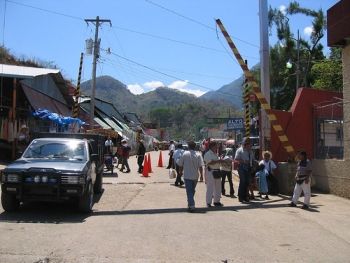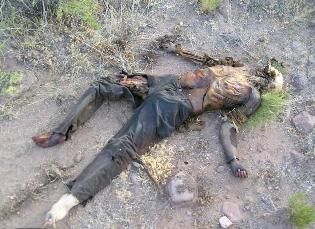
Publisher:
Bonnie King
CONTACT:
Newsroom@Salem-news.com
Advertising:
Adsales@Salem-news.com

~Truth~
~Justice~
~Peace~
TJP
Aug-30-2010 21:20

 TweetFollow @OregonNews
TweetFollow @OregonNews
Mexico's Arizona Moment
Salem-News.comDespite the dangers, migrants say they will continue to travel to the U.S.
 Courtesy: Richard Cunningham Blog |
(LAS CRUCES, NM) - If Arizona’s SB 1070 law, underlined by the continuing deaths of migrants in the inhospitable, blazing desert of the Southwestern state, dramatizes the crisis of US immigration policy, then the mass murder of 72 Central and South American migrants in the northern Mexican border state of Tamaulipas last week showcases a similar and widening crisis in Mexico.
The San Fernando Massacre, which occurred August 22 in a rural area about 90 miles south of the US border, was widely condemned by human rights advocates as the horrific culmination of years of corruption and neglect on the part of Mexican immigration and law enforcement officials who are often accused of collaborating with human traffickers for extortion and other purposes.
“Immigrants are raped, murdered, beaten and tortured every day,” Ruben Figueroa, coordinator of a migrant shelter in the southern state of Tabasco, told the Mexican press. “The principal zones of danger are in Veracruz, Tabasco, Mexico state, Tamaulipas, Baja California, and Coahuila. We think there are other tombs, clandestine graves and pits that should be investigated.”
A new report from the former ruling Institutional Revolutionary Party and the affiliated National Confederation of Popular Organizations claimed 60,000 Central and South American migrants disappeared while traveling through Mexico to the US from 1998 to 2008.
A young man who reportedly survived the Tamaulipas massacre, 18-year-old Ecuadoran national Luis Freddy Lala Pomavilla, was quoted in the Mexican press as stating that the migrants slain in San Fernando were gunned down after being kidnapped by presumed members of the Zetas drug cartel.
According to Lala, the victims were lined up and shot after turning down offers to work for the cartel. Separately, Daniel Boche, a relative of three Guatemalans who were among the victims, confirmed that his family had received a phone call from Mexico demanding money for the safe return of loved ones before they were killed.
As Frontera NorteSur went to press, Mexican authorities were still identifying the slain migrants. A young man, Eduardo Rico Perez, has been detained in connection with the San Fernando crimes. A leading voice for migrant rights, Roman Catholic Bishop Raul Vera of Saltillo, Coahuila, termed the massacre of migrants from Guatemala, Honduras, El Salvador, Ecuador and Brazil “characteristic of the holocaust.”
Maureen Meyer, Mexico and Central America program associate for the non-profit Washington Office on Latin America (WOLA) called the San Fernando Massacre an “extreme example” of the routine violence and mistreatment encountered by migrants traveling through Mexico en route to the United States.
In a phone interview with Frontera NorteSur, Meyer said Mexican officials were well aware of well-traveled migrant routes and could be complicit in human rights violations. Hard to miss, Central Americans and members of other nationalities frequently travel in large groups on trains, buses and trucks.
In multiple instances, Mexican immigration officials and security forces have been tied to the systematic trafficking or kidnapping of migrants who are held until relatives, usually in the US, pay ransom. Other victims are forced to work for criminal bands. Meyer compared the kidnapping of migrants in Mexico with the same practice of some human traffickers in the state of Arizona. The two situations, she said, highlight the “vulnerability of migrants in both countries.”
 Dead immigrant in Mexico. Courtesy: GreensBoring.com |
Workers for the Roman Catholic Church’s network of migrant shelters that stretches across the country and provides food and refuge to travelers from Central America and other regions have long denounced serious human rights violations.
Last March, Mexican Church representatives and the Miguel Agustin Pro Human Rights Center presented testimony to the Inter-American Commission on Human Rights in Washington, D.C. on the plight of migrants in Mexico.
The presenters petitioned the Inter-American Commission to send a special investigator to Mexico to probe the conditions faced by migrants. Months later, the San Fernando Massacre splashed the headlines. At the time of the slaughter, Mexico and El Salvador were in the process of revising bilateral agreements on the treatment and repatriation of migrants.
Exposed on August 24, the killings of 58 men and 14 women produced the latest human rights crisis for the Calderon administration. The massacre was quickly condemned by Amnesty International, the Inter-American Commission on Human Rights, the United Nations office in Mexico, the Organization of American States and the ambassadors of 24 Latin American countries.
Non-governmental groups in the Americas issued a communiqué decrying the murders. The signatories included the Miguel Agustin Pro Human Rights Center, Relatives Committee of the Deceased and Disappeared of El Salvador, Global Workers Justice Alliance, Casas Migrantes Americas and dozens of others.
Mexican Foreign Minister Patricia Espinoza pledged that the investigation of the mass slaughter, which was turned over to Mexico’s federal attorney general’s office, would advance “as rapidly as possible.”
Espinoza called the killings “violent, cowardly and criminal acts that put all the governments and peoples of Latin America into a state of mourning”
Mexico plans on issuing travel advisories in Central and South America about the hazards facing migrants. The San Fernando Massacre touched off a new crisis of confidence in the Calderon administration. The opposition Party of the Democratic Revolution called for the sacking of National Migration Institute Commissioner Cecilia Romero and a shake-up of the institution that enforces Mexican immigration laws.
Last week, however, Romero told reporters that her agency had rescued 2,750 migrants this year and possibly prevented occurrences similar to the San Fernando Massacre.
On August 28, hundreds of migrants and their supporters staged unusual demonstrations in Arriaga, Chiapas, and Saltillo, Coahuila. Demanding the right of transit and protection from the Mexican state, the protesters carried signs that bore slogans like “I am a person, not merchandise” and “I deserve to live.”
In Arriaga, the administrative assistant for the local migrant shelter revealed that two Hondurans showed up last week after being kidnapped, extorted and released by alleged Zetas in Tierra Blanca, Veracruz. Hinting at another possible motive for attacks against migrants, Carlos Bartolo Solis said the victims were warned not to continue north on their journey. Despite the dangers, another Honduran in Arriaga, Oscar Robles Mata, said he still planned to travel to the US since he would do whatever it took to help his family.
WOLA’s Maureen Meyer contended that Mexico must ensure that not only are the perpetrators of the San Fernando Massacre brought to justice, but that government agents involved in violations of migrants’ human rights are held accountable and prosecuted. On a broader note, Meyer stressed how the treatment of migrants passing through Mexico has worsened since the US began demanding that the Mexican government take more action in controlling migrant routes, thus channeling thousands of people into the hands of organized criminal networks.
In both the US and Mexico, she added, the push factors behind migration are largely ignored in current policy debates. “We view migration as a legislative issue,” Meyer said. “People will keep coming 10 years from now if we don’t start having a focus on economic policy and trade policy.”
In Tamaulipas, meanwhile, the gravity of the situation on the ground was demonstrated in the immediate days after the grim discovery in San Fernando. On August 27, two car bombs exploded in the state capital of Ciudad Victoria; one of the devices blew up outside the local Televisa affiliate. Two days earlier, Roberto Javier Suarez Vazquez, the investigator for the Tamaulipas state attorney general’s office who was initially assigned the San Fernando case, vanished from the face of the earth.
Additional sources:
- El Diario de Juarez, August 27, 2010.
- La Jornada, August 25, 26, 27, 28, 29, 2010. Articles by Victor Ballinas, Gustavo Castillo Garcia, Angeles Mariscal, Afp, Dpa and Notimex.
- El Universal, August 26, 27 and 29, 2010. Articles by Francisco Gomez, Gerardo Mejia, Maria de Jesus Peters, Notimex, and editorial staff.
- Associated Press, August 27, 2010. Article by E. Eduardo Castillo.
- El Sur/Agencia Reforma, August 26 and 29, 2010.
- Proceso/Apro, August 25 and 26, 2010. Articles by Gloria Leticia Diaz and editorial staff./li>
Frontera NorteSur (FNS): on-line, U.S.-Mexico border news
Center for Latin American and Border Studies
New Mexico State University Las Cruces, New Mexico
Articles for August 29, 2010 | Articles for August 30, 2010 | Articles for August 31, 2010

googlec507860f6901db00.html
Salem-News.com:



Terms of Service | Privacy Policy
All comments and messages are approved by people and self promotional links or unacceptable comments are denied.
[Return to Top]
©2025 Salem-News.com. All opinions expressed in this article are those of the author and do not necessarily reflect those of Salem-News.com.